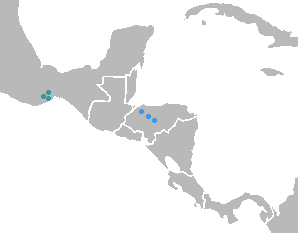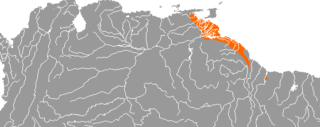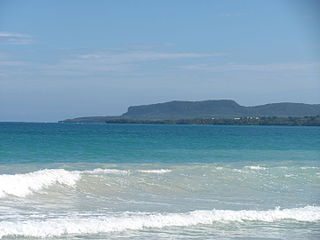Related Research Articles
The Lucayan people were the original residents of The Bahamas before the European conquest of the Americas. They were a branch of the Taínos who inhabited most of the Caribbean islands at the time. The Lucayans were the first indigenous Americans encountered by Christopher Columbus. Shortly after contact, the Spanish kidnapped and enslaved Lucayans, with the displacement culminating in the complete eradication of the Lucayan people from the Bahamas by 1520.

The Ciboney, or Siboney, were a Taíno people of central Cuba, Jamaica, and the Tiburon Peninsula of Haiti. A Western Taíno group living in central Cuba during the 15th and 16th centuries, they had a dialect and culture distinct from the Classic Taíno in the eastern part of the island, though much of the Ciboney territory was under the control of the eastern chiefs. Confusion in the historical sources led 20th-century scholars to apply the name "Ciboney" to the non-Taíno Guanahatabey of western Cuba and various archaic cultures around the Caribbean, but this is deprecated.

The Lucayan Archipelago, also known as the Bahamian Archipelago, is an island group comprising the Commonwealth of The Bahamas and the British Overseas Territory of the Turks and Caicos Islands. The archipelago is in the western North Atlantic Ocean, north of Cuba and the other Antillean Islands, and east and south-east of Florida.

The Guanahatabey were an indigenous people of western Cuba at the time of European contact. Archaeological and historical studies suggest the Guanahatabey were archaic hunter-gatherers with a distinct language and culture from their neighbors, the Taíno. They might have been a relic of an earlier culture that spread widely through the Caribbean before the ascendance of the agriculturalist Taíno.

Samana Cay is a now uninhabited island in the Bahamas believed by some researchers to have been the location of Christopher Columbus's first landfall in the Americas on October 12, 1492.

Saona Island is a 110 square kilometer tropical island located off the south-east coast in Dominican Republic's La Altagracia province. It is a government-protected nature reserve and is part of Parque Nacional Cotubanamá.
At the time of first contact between Europe and the Americas, the indigenous peoples of the Caribbean included the Taíno of the northern Lesser Antilles, most of the Greater Antilles and the Bahamas, the Kalinago of the Lesser Antilles, the Ciguayo and Macorix of parts of Hispaniola, and the Guanahatabey of western Cuba. The Kalinago have maintained an identity as an indigenous people, with a reserved territory in Dominica.

A zemi or cemi was a deity or ancestral spirit, and a sculptural object housing the spirit, among the Taíno people of the Caribbean. Cemi’no or Zemi’no is a plural word for the spirits. They were venerated on the Greater Antilles

Jicaquean, also known as Tolan, is a small language family of Honduras. There are two attested Jicaquean languages, Tol and Western Jicaque, which Campbell (1997) reports were about as distant as English and Swedish. Only Tol survives.

The Bahoruco Mountain Range—Sierra de Bahoruco is a mountain range located in the far southwestern region of the Dominican Republic. It is within Pedernales, Independencia, Barahona, and Bahoruco Provinces. A large part of the area is protected within the Sierra de Bahoruco National Park, also a Biosphere reserve.

Warao is the native language of the Warao people. A language isolate, it is spoken by about 33,000 people primarily in northern Venezuela, Guyana and Suriname. It is notable for its unusual object–subject–verb word order. The 2015 Venezuelan film Gone with the River was spoken in Warao.
The Haina River is a river of the Dominican Republic. It is located on the oriental limit of hydrographic district of Azua, Baní, and San Cristóbal.

Taíno is an extinct Arawakan language that was spoken by the Taíno people of the Caribbean. At the time of Spanish contact, it was the most common language throughout the Caribbean. Classic Taíno was the native language of the Taíno tribes living in the northern Lesser Antilles, Puerto Rico, the Turks and Caicos Islands, and most of Hispaniola, and expanding into Cuba. The Ciboney dialect is essentially unattested, but colonial sources suggest it was very similar to Classic Taíno, and was spoken in the westernmost areas of Hispaniola, the Bahamas, Jamaica, and most of Cuba.

Several languages of the Greater Antilles, specifically in Cuba and Hispaniola, appear to have preceded the Arawakan Taíno. Almost nothing is known of them, though a couple recorded words, along with a few toponyms, suggest they were not Arawakan or Cariban, the families of the attested languages of the Antilles. Three languages are recorded: Guanahatabey, Macoris, and Ciguayo.

Guaniguanico, also known as Cordillera de Guaniguanico, is a mountain range of western Cuba that extends from the centre-west of Pinar del Río Province to the western area of Artemisa Province. It is formed by the subranges of Sierra del Rosario and Sierra de los Órganos.

Guanahatabey (Guanajatabey) was the language of the Guanahatabey people, a hunter-gatherer society that lived in western Cuba until the 16th century. Very little is known of it, as the Guanahatabey died off early in the period of Spanish colonization before substantial information about them was recorded. Evidence suggests it was distinct from the Taíno language spoken in the rest of the island.

Macorix was the language of the northern coast of what is today the Dominican Republic. Spanish accounts only refer to three languages on the island: Taino, Macorix, and neighboring Ciguayo. The Macorix people appear to have been semi-sedentary and their presence seems to have predated the agricultural Taino who came to occupy much of the island. For the early European writers, they shared similarities with the nearby Ciguayos. Their language appears to have been moribund at the time of the Spanish Conquest, and within a century it was extinct.

Ciguayo (Siwayo) was the language of the Samaná Peninsula of Hispaniola at the time of the Spanish Conquest. The Ciguayos appear to have predated the agricultural Taino who inhabited much of the island. The language appears to have been moribund at the time of Spanish contact, and within a century it was extinct.

The Ciguayos were a group of indigenous people who inhabited the Samaná Peninsula and its adjoining regions in the present-day Dominican Republic. The Ciguayos appear to have predated the agricultural Taíno who inhabited much of the island. Ciguayo was spoken on the northeastern coast of the Magua region from Nagua southward to at least the Yuna River, and throughout all of the Samana Peninsula.
References
- 1 2 Granberry, Julian; Vescelius, Gary (2004). Languages of the Pre-Columbian Antilles. Tuscaloosa, AL: University of Alabama Press. ISBN 0-8173-5123-X.